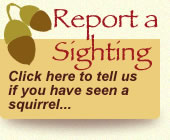Habitat Management For Red Squirrels
Habitat Management
The following is a summary of ‘Woodlands for Red Squirrels’ – a practical handbook produced by the project for forest managers and anyone involved with woodlands in red squirrel areas. If you would like a copy, please contact your Red Squirrel Conservation Officer.
Managing Woodland for Red Squirrels
Squirrels are woodland animals and rely on trees for shelter and food. Red squirrels in particular require a varied and reliable source of tree seeds and nuts to ensure their survival.
 Whilst habitat management for red squirrels is important, it must be noted that management for a single species may sometimes conflict with the conservation of other wildlife or other management objectives. For this reason it is important that all factors are considered prior to commencing any management.
Whilst habitat management for red squirrels is important, it must be noted that management for a single species may sometimes conflict with the conservation of other wildlife or other management objectives. For this reason it is important that all factors are considered prior to commencing any management.
In general, habitat improvement is likely to be more successful in larger woodland blocks (over 200 hectares) than in small woods. However, a number of suitable small woods in close proximity can support populations of red squirrels.
• Coniferous Woodland
Coniferous woodlands offer the greatest potential for supporting red squirrels in the presence of grey squirrel expansion, as small-seeded conifers are less favoured by grey squirrels.
Blocks of conifer woodland over 200 hectares and ideally over 2000 hectares, offer the best opportunity for long term red squirrel conservation. However, even aged plantations dominated by Sitka spruce only support low densities of red squirrels and slight alterations in woodland management in these areas could significantly improve the situation for red squirrels, while still disadvantaging the greys.
• Species Composition
A mixture of tree species is important to reduce the impact of poor cone years in one particular species. Species of value to red squirrels include Norway spruce (Picea abies), Scots pine (Pinus sylvestris), Corsican pine (Pinus nigra var.) and Larch ( Larix decidua).
 As large seeded broadleaved trees attract grey squirrels, new planting of broadleaved tree species within or adjacent to large areas of coniferous woodland should use small-seeded species such as Rowan (Sorbus aucuparia), Willow (Salix spp.), Birch (Betula spp.), Alder (Alnus glutinosa) or Ash (Fraxinus excelsior) where possible.
As large seeded broadleaved trees attract grey squirrels, new planting of broadleaved tree species within or adjacent to large areas of coniferous woodland should use small-seeded species such as Rowan (Sorbus aucuparia), Willow (Salix spp.), Birch (Betula spp.), Alder (Alnus glutinosa) or Ash (Fraxinus excelsior) where possible.
Areas should be designated for long-term retention, preferably at the edges of plantations where coning is heavier, although the risk of windblow on these trees will need to be considered.
• Management
Minimise felling or thinning trees between February and July to avoid disturbance during the red squirrel breeding season. Felling should take place in small areas, in keeping with the scale of the woodland and the landscape. Retaining links between seed-producing areas will help to prevent the isolation of red squirrels from each other, from food sources and will help to reduce losses from predation.
Undertake grey squirrel control if they are directly competing with red squirrels in the same woodland.
• Age Structure
 Ideally there should be around one-third of each of the following tree age classes in the wood: younger than 15 years; 15-30 years; older than 30 years.
Ideally there should be around one-third of each of the following tree age classes in the wood: younger than 15 years; 15-30 years; older than 30 years.
• Broadleaved Woodland
Management for red squirrels will have a lower likelihood of success in this type of woodland if grey squirrels are, or are likely to become, present.
The primary management objective of many broadleaved woodlands will not be red squirrel conservation. This management advice cannot be targeted purely for red squirrels whether grey squirrels are present or not. However, the following operations are beneficial to red squirrels and woodland ecology in general.
- Reduce grazing to encourage natural regeneration of the understorey and shrub layer.
- Leave dead wood to rot down in situ. This provides a range of invertebrate habitats, as well as encouraging the growth of fungi as an alternative food for squirrels.
Click here for a printable version (pdf)

Please note this link will open a new window which will take you to the Scottish Wildlife Trust website where you can record your squirrel sightings.
Website by
Stewartry Technology





